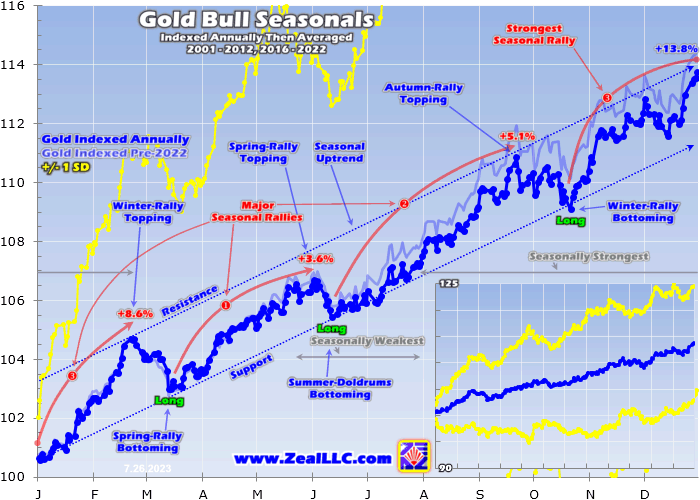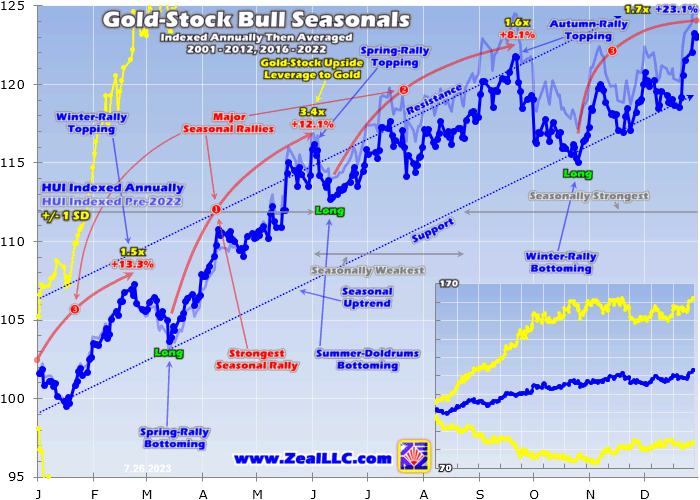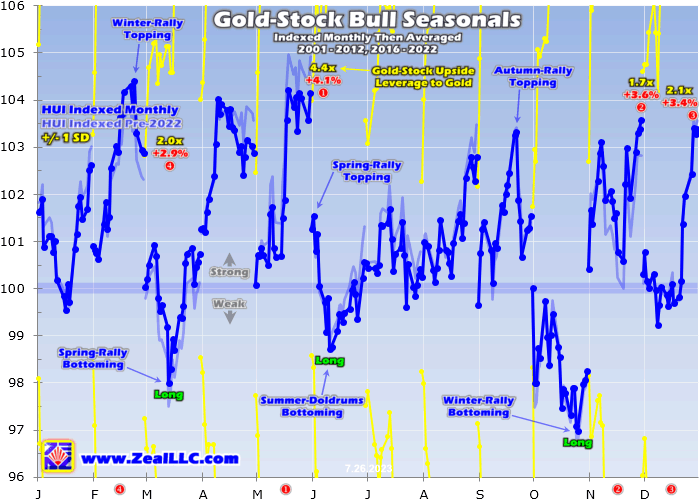The gold miners’ stocks have resumed grinding higher on balance, mean reverting out of their summer-doldrums selloff. Their usual seasonal autumn rally driven by gold’s own looks to be gathering steam. Outsized Asian gold demand typically fuels solid-to-good precious-metals gains this time of year. And the coming months have much-better upside potential than normal with the Fed’s extreme rate-hike cycle ending.
Seasonality is the tendency for prices to exhibit recurring patterns at certain times during the calendar year. While seasonality doesn’t drive price action, it quantifies annually-repeating behaviors driven by sentiment, technicals, and fundamentals. We humans are creatures of habit and herd, which naturally colors our trading decisions. The calendar year’s passage affects the timing and intensity of buying and selling.
Gold stocks display strong seasonality because their price action amplifies that of their dominant primary driver, gold. Gold’s seasonality generally isn’t driven by supply fluctuations like grown commodities see, as its mined supply remains relatively steady year-round. Instead gold’s major seasonality is demand-driven, with global investment demand varying considerably depending on the time in the calendar year.
This gold seasonality is fueled by well-known income-cycle and cultural drivers of outsized gold demand from around the world. Starting in late summers, Asian farmers begin to reap their harvests. As they figure out how much surplus income was generated from all their hard work during the growing season, they wisely plow some of their savings into gold. Asian harvest is followed by India’s famous wedding season.
Indians believe getting married during their autumn festivals is auspicious, increasing the likelihood of long, successful, happy, and even lucky marriages. And Indian parents outfit their brides with beautiful and intricate 22-karat gold jewelry, which they buy in vast quantities. That’s not only for adornment on their wedding days, but these dowries secure brides’ financial independence within their husbands’ families.
So during its bull-market years, gold has tended to enjoy sizable-to-strong autumn rallies driven by these sequential episodes of outsized demand. Naturally the gold stocks follow gold higher, amplifying its gains due to their profits leverage to the gold price. Today gold stocks are once again back at their most-bullish seasonal juncture, the transition between the typically-drifting summer doldrums and big autumn rallies.
Since it is gold’s own demand-driven seasonality that fuels gold stocks’ seasonality, that’s logically the best place to start to understand what’s likely coming. This old research thread focuses on modern bull-market seasonality, as bull and bear price action is quite different. Gold enjoyed a mighty 638.2% bull run from April 2001 to August 2011, fueling gold stocks skyrocketing 1,664.4% per their leading index then!
Following that secular juggernaut, gold consolidated high then started correcting into 2012. But the yellow metal didn’t enter formal bear territory down 20%+ until April 2013. That beast mauled gold on and off over several years, so 2013 to 2015 are excluded from these seasonal averages. Gold finally regained bull status powering 20%+ higher in March 2016, then its modest gains grew to 96.2% by August 2020.
Another high consolidation emerged after that, where gold avoided relapsing into a new bear despite a serious correction. Later the yellow metal started powering higher again, coming within 0.5% of a new nominal record in early March 2022 after Russia invaded Ukraine. So 2016 to 2021 definitely proved bull years too, with 2022 really looking like one early on. Then Fed officials panicked, unleashing market chaos.
Inflation was raging out of control thanks to their extreme money printing. In just 25.5 months following the March 2020 pandemic-lockdown stock panic, the Fed ballooned its balance sheet an absurd 115.6%! That effectively more than doubled the US monetary base in just a couple years, injecting $4,807b of new dollars to start chasing and bidding up the prices on goods and services. That fueled an inflation super-spike.
With big inflation running rampant, Fed officials frantically executed the most-extreme tightening cycle in this central bank’s history. They hiked their federal-funds rate an astounding 450 basis points in just 10.6 months, while also selling monetized bonds through quantitative tightening! That ignited a huge parabolic spike in the US dollar, unleashing massive gold-futures selling slamming gold 20.9% lower into early September.
That was technically a new bear market, albeit barely and driven by an extraordinary anomaly that was unsustainable. Indeed gold soon rebounded sharply, exiting 2022 with a trivial 0.3% full-year loss. Gold kept on powering higher, reentering bull territory up 20.2% in early February 2023! So I’m also classifying 2022 as a bull year for seasonality research. Gold’s modern bull years include 2001 to 2012 and 2016 to 2022.
Prevailing gold prices varied radically across these secular spans, running just $257 when gold’s mighty 2000s bull was born to August 2020’s latest record high of $2,062. That vast range of gold levels spread over all those long years has to first be rendered in like-percentage terms in order to make them perfectly comparable with each other. Then they can be averaged together to distill out gold’s bull-market seasonality.
That’s accomplished by individually indexing each calendar year’s gold price action to its final close of the preceding year, which is recast at 100. Then all gold price action of the following year is calculated off that common indexed baseline, normalizing all years. So gold trading at 110 simply means it has rallied 10% off the prior year’s close. Gold’s previous seasonality before 2022 was added is shown in light blue.

If investors understood gold’s phenomenal performance in recent decades, it would be far more popular with allocations included in every portfolio. Through 19 of the last 22 years, gold has enjoyed fantastic average calendar-year gains of 13.8%! And the great majority of that was before the Fed recklessly more than doubled the US money supply. With inflation raging since, everyone should have 5% to 10% in gold.
Seasonally gold enjoys three distinct rallies occurring in autumn, winter, and spring. Their average gains from 2001 to 2012 and 2016 to 2022 clocked in at 5.1%, 8.6%, and 3.6%. Gold’s autumn rallies tended to start in mid-June at its seasonal uptrend’s lower support. Then they typically powered higher on balance until hitting upper resistance in late September. This year’s price action is nicely tracking that seasonal pattern.
Gold’s latest strong upleg achieved its high-water mark in early May, powering up an impressive 26.3% since late September’s deep secular low on the Fed’s extreme rate hikes. But challenging all-time-record nominal highs, gold was seriously overbought. The yellow metal had stretched 13.2% above its 200-day moving average. That hadn’t hit the upleg-slaying danger zone over 16%, but a pullback was still in order.
Those healthy mid-upleg selloffs exist to rebalance sentiment, to bleed off excessive greed before it metastasizes into lethal euphoria. So over the next eight weeks or so into late June, gold indeed pulled back 6.9%. Though that was well shy of 10%+ correction territory and gold bounced well above both its 200dma and uptrend support, that normal pullback really accomplished its mission of slaughtering bullish sentiment.
The summer doldrums certainly contributed, gold’s weakest time of the year seasonally centered in June. Traders check out mentally during peak vacation season, getting distracted from following markets in general. That leaves gold drifting in something of a sentiment wasteland, a contrarian investment that is largely forgotten. But the yellow metal rebounded strongly in July, starting its usual nice autumn rally.
Between late June to mid-July, gold surged 3.6% primarily on three weaker-than-expected US economic-data prints. Those started with a miss in monthly jobs, then continued first on cooler CPI inflation and later slower retail sales. All these were Fed-dovish, slashing odds for more rate hikes after this week’s baked-in 11th one of this cycle. Gold weathered that nicely, although it got hit Thursday on better GDP data.
Overall gold’s early autumn-rally technicals this year have proven very bullish. In merely eight trading days into mid-July, gold recovered nearly half of its entire pullback losses! That rebound rally included a decisive 50dma upside breakout, confirming a short-term reversal. That key technical line has largely held as support since, even despite that Fed-hawkish GDP upside surprise. Gold is looking really good.
Typically in late July, gold has averaged 6.8% year-to-date gains in these modern bull-market years. So far in 2023, the yellow metal has bested that up 8.2% mid-week. On average gold edged a trivial 0.0% lower in June in the worst of the summer doldrums. Then it rebounded 1.0% in July accelerating to 1.7% in August as its autumn rally gathered steam. That continued into late September’s peak with another 1.8% surge.
Gold’s improving autumn-rally performance as summers progress is readily evident in this seasonal chart. After drifting lower to sideways in June, gold perks up in July before its ascent slope really steepens in August and most of September. That outsized Indian gold demand this time of year has long fueled nice autumn rallies. There’s no reason that seasonality shouldn’t happen again in 2023, driving gold well higher.
Gold’s late-summer setup this year is actually much better than most years’. After an economy-crushing 525bp of rate hikes in just 16.3 months, this Fed-rate-hike cycle is effectively over. Back in mid-June, top Fed officials predicted one more 25bp hike beyond this week’s later this year. But even if that comes to pass, this US-dollar-goosing gold-slamming extreme rate-hike cycle is already more than 19/20ths finished.
With the Fed running out of room to keep hiking without bankrupting the heavily-indebted US government, hawkish jawboning is losing its efficacy. Traders are increasingly interpreting Fedspeak as dovish. This week’s FOMC statement didn’t hint at more hikes, and the Fed chair said “Looking ahead, we will continue to take a data-dependent approach in determining the extent of additional policy firming that may be appropriate.”
Since the Fed’s initial hike of this cycle in March 2022, gold price action has been dominated by currency traders filtering everything through a Fed-hawkish-or-dovish lens. When Fedspeak or major economic data looks to support more rate hikes, the US dollar rallies so gold-futures speculators sell. When the opposite happens, the dollar falls so they buy. That constant dollar-bullish threat of more hikes is disappearing.
That portends the benchmark US Dollar Index continuing to roll over and weaken on balance, which isn’t a new trend. The USDX peaked at an extreme 20.4-year secular high in late September as gold carved its own stock-panic-grade 2.5-year low! Since then the primary reason gold has blasted 26.3% higher at best is the USDX has collapsed 12.6% at worst. This dollar bear growing will fuel big gold-futures buying.
And speculators’ current positioning implies they have lots of room to keep adding longs which drives gold higher. As of the latest weekly Commitments of Traders report before this essay was published, total spec longs were only 3/8ths up into their probable gold-upleg trading range. That means these super-leveraged traders dominating short-term gold price action still have the majority of their likely buying left to do!
As traders increasingly realize this monster Fed-rate-hike cycle is effectively over, the dollar will continue to weaken. The resulting big gold-futures buying will drive gold higher, soon becoming self-feeding. The more specs buy, the faster and higher gold rallies, the more other specs will follow them in to chase those gains. This dynamic should start attracting back missing-in-action investors too, supercharging gold’s upside.
So odds favor this year’s autumn rally growing outsized relative to multi-decade gold-bull-year seasonal precedent. That certainly bodes well for gold stocks in the next couple months. Their leading GDX VanEck Gold Miners ETF tends to amplify material gold moves by 2x to 3x. But only birthed in May 2006, GDX is too young for this long-term seasonal analysis. For that we need the classic HUI gold-stock index.
It is functionally interchangeable with GDX, containing the same major gold miners. To test this, I remade this seasonal research thread’s underlying spreadsheet by plugging in GDX instead of the HUI starting in 2007. The resulting charts proved all but identical, so for consistency’s sake I’m continuing to advance these studies with the HUI. The gold stocks are already thriving in July, leveraging gold’s upside like usual.

Major gold stocks have averaged outstanding 23.1% gains during 19 of the last 22 years! With an epic track record like that, it blows my mind that this high-potential contrarian sector isn’t more widely followed by traders. Everyone who likes multiplying their wealth should keep an eye on gold stocks and maintain some reasonable portfolio allocation like 10% to 15%. Gold stocks are ultimately leveraged plays on gold.
So they have long enjoyed a seasonal autumn rally just like the metal they mine. But with their autumn, winter, and spring rallies averaging 8.1%, 13.3%, and 12.1% gains, this late-summer surge has usually been the weakest. Festering bearish sentiment lingering from gold stocks’ summer-doldrums grind lower is a factor. Even contrarian traders tend to remain skeptical on this sector until gold starts looking bullish again.
Last year’s extreme anomaly also really dragged down the autumn-rally average. Gold stocks plunged with gold late last summer as the US dollar skyrocketed parabolic on those extreme Fed rate hikes. The light-blue line in this chart again shows what gold-stock seasonals looked like before 2022 was added in. Excluding that outlier, the gold stocks’ autumn rally has generally been considerably stronger averaging +9.5%.
And gold-stock fortunes are already looking way better this summer. GDX blasted up 63.9% between late September to mid-April as gold’s underlying upleg powered higher. The gold stocks nearly carved a new upleg high with their metal in early May, but narrowly missed. Then they naturally got sucked into gold’s pullback, with GDX falling 18.9% by early July. That was perfectly normal, amplifying gold’s downside by 2.7x.
The major gold stocks rebounded dramatically with gold this month on that Fed-dovish economic data. GDX shot up 12.3% in just eight trading days on that, leveraging gold’s rebound by a big 3.4x! And this leading gold-stock benchmark also achieved its own decisive 50dma upside breakout, confirming this reversal is the real deal! Mid-week GDX was still 8.9% above its recent low, better than average autumn rallies.
If gold continues powering higher on balance as it ought to during this autumn-rally span running into late September, the gold stocks will amplify its gains like usual. For a variety of reasons analyzed in recent essays, today’s gold upleg ought to challenge 40% before giving up its ghost. That implies $2,275 gold at some point, another 15% higher than mid-week levels. That would drive additional 30% to 45% GDX gains.
This probably won’t all be achieved in just the next couple months’ autumn-rally timeframe. But both the metal and its miners’ stocks have lots of upside potential from here. This favorable seasonal tailwind will accelerate any further upleg gains primarily driven by technicals, sentiment, and fundamentals. And the lion’s share of gold stocks’ autumn rallies happen in August and most of September, certainly a bullish omen.
This last chart slices gold-stock seasonals into calendar months, using a similar methodology. Each is indexed to 100 at the previous month’s final close, then all like-months’ indexes are averaged together. These same modern-gold-bull years of 2001 to 2012 and 2016 to 2022 are included. Between now and late September is an important time to be fully-deployed in gold stocks to ride their usual autumn rally!

Gold stocks’ entire seasonal autumn rally runs from mid-June to late September, mirroring gold’s. That peak-summer-doldrums month of June tends to be weak for the gold miners, averaging just 0.6% gains in HUI and GDX terms. Interestingly July is even worse, with the major gold stocks merely eking out 0.4% rallies on average from 2001 to 2012 and 2016 to 2022. Again bearish sector sentiment lingers for some time.
This July the major gold stocks are already faring wildly better than seasonal norms, with GDX still up a big 5.1% month-to-date as of mid-week! That’s a great foundation to undergird a coming much-bigger-than-normal autumn rally. The vast majority of gold stocks’ autumn-rally gains come in August and most of September, where they surged an average of 2.8% then another 3.3%! GDX should outperform this year.
That coming big gold-futures buying on the looming end of this Fed-rate-hike cycle is the primary reason, as gold stocks will follow gold. But the miners’ strong fundamentals should help entice traders back. The gold stocks are just starting their Q2’23 earnings season, which should prove impressive. Many miners have forecast growing gold production as 2023 marches on, helping to drive down their unit mining costs.
As I analyzed in last week’s essay on GDX’s decisive 50dma breakout, that is combining with the highest quarterly-average gold prices ever to make for big earnings. Last quarter gold averaged a record $1,978 on close, surging a strong 5.6% year-over-year! Traders’ motivation to chase this sector should mount as they see plenty of miners report surging profits and operating cash flows on higher gold and lower costs.
With gold stocks’ autumn-rally setup this year quite bullish, it’s time to get redeployed in gold stocks. We have long specialized in fundamentally-superior smaller mid-tier and junior miners, which outperform the majors when gold advances. We added fully 20 new gold-stock trades in our newsletters over several weeks into early July as this sector bottomed. Their unrealized gains are already running as high as +27.8%.
Successful trading demands always staying informed on markets, to understand opportunities as they arise. We can help! For decades we’ve published popular weekly and monthly newsletters focused on contrarian speculation and investment. They draw on my vast experience, knowledge, wisdom, and ongoing research to explain what’s going on in the markets, why, and how to trade them with specific stocks.
Our holistic integrated contrarian approach has proven very successful, and you can reap the benefits for only $8 an issue (now 33% off!). We research gold and silver miners to find cheap fundamentally-superior mid-tiers and juniors with outsized upside potential. Sign up for free e-mail notifications when we publish new content. Even better, subscribe today to our acclaimed newsletters and start growing smarter and richer!
The bottom line is gold and its miners’ stocks are reentering their strong season. That starts with nice autumn rallies mostly in August and September, normally fueled by seasonal Asian gold demand. This year has much-better upside potential than usual though with the Fed’s monster rate-hike cycle finally nearing its end. As traders stop expecting more rate hikes, the US dollar will weaken driving gold-futures buying.
Speculators still have room to do the majority of their likely long-contract buying in this gold upleg. As that pushes gold higher, its upside momentum will feed on itself attracting in more buying including investors. The gold stocks will leverage gold’s coming gains like usual, probably fueling an outsized autumn rally this year. Their imminent Q2 results are likely to show strong fundamentals too, increasing their allure.
Adam Hamilton, CPA
July 28, 2023
Copyright 2000 - 2023 Zeal LLC (www.ZealLLC.com)

